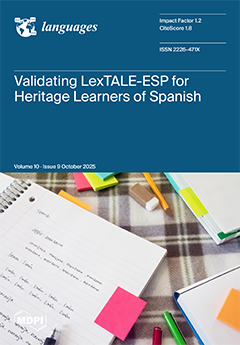This paper investigates the morphosyntactic and semanto-pragmatic behavior of the German neo-pronoun
xier, a gender-neutral form used to refer to nonbinary individuals. Framed within the Minimalist Program, the analysis explores how
xier carries a gender feature that encodes nonbinary identity—not through binary
[...] Read more.
This paper investigates the morphosyntactic and semanto-pragmatic behavior of the German neo-pronoun
xier, a gender-neutral form used to refer to nonbinary individuals. Framed within the Minimalist Program, the analysis explores how
xier carries a gender feature that encodes nonbinary identity—not through binary morphological marking, but via presupposition. The use of
xier triggers a presupposition about the referent’s identity: that they are nonbinary. This gender feature is not absent, void or underspecified, but interpretively rich and categorically distinct. The analysis thus rejects any account treating
xier as lacking gender. Instead, it argues that
xier exemplifies a grammatical strategy of encoding gender beyond the binary, through formal structures that engage the interpretive system directly. The paper further argues that
xier’s morphosyntactic profile—including its compatibility with standard agreement morphology—shows that nonbinary gender can be syntactically represented and participate fully in φ-feature interactions. Drawing on cross-linguistic comparisons (e.g., English
they and the Italian adaptation
ze), the study shows how presuppositional gender encoding supports stable φ-Agree, interface-compatible labeling without requiring binary valuation. The proposal refines the architecture of φ-features by allowing for interpretively active gender categories that are formally encoded even when they do not match traditional binary specifications. This account offers a model for how minimalist syntax can accommodate socially driven innovations without abandoning core theoretical principles.
Xier, in this light, demonstrates that grammatical systems can expand to encode emerging reference categories—not by omitting gender, but by formally encoding nonbinary gender via presupposition. This study is the first to offer a formal syntactic account of a German neo-pronoun, linking socially driven innovation to core φ-feature operations like Agree and valuation.
Full article





